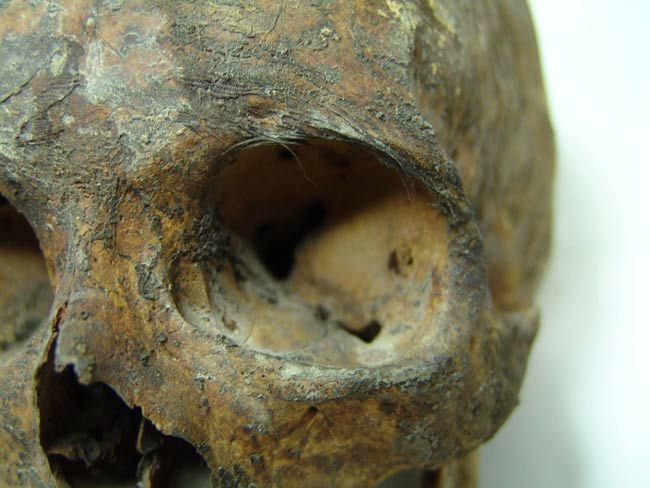Greek Mummy Found in Lead Coffin

A mummy of a middle-aged woman dating to Ancient Greek times has been discovered in a lead coffin inside a marble sarcophagus, the first clear indication of embalming in Greece from the era when the Romans ruled there.
A research team co-led by Frank Rühli of the University of Zurich was able to show that various resins, oils and spices were used to embalm the body, dating to A.D. 300. Along with the skeleton, the methods partially preserved some soft tissues from the body, most of which are now brittle, thin and extremely desiccated, including eyebrows, a muscle in the hand, hair and blood cells.
Rühli told LiveScience that this a "unique finding for this temporal and spatial setting."
The body was covered with a gold-embroidered purple silk cloth, indicating that the woman was probably of high social status, Rühli said. Her bones reveal that she was somewhere between 50 and 60 years old. The finding will be detailed in an upcoming issue of the Journal of Archaeological Science.
The mummy currently is held at the Archaeological Museum of Thessaloniki, Greece.
Myrrh, fats and resins
The sarcophagus was uncovered initially in 1962 during an archaeological dig in Northern Greece, on the eastern cemetery of Thessaloniki, which was used from the Hellenistic to the Byzantine Periods for burial and other ritual practices.
Sign up for the Live Science daily newsletter now
Get the world’s most fascinating discoveries delivered straight to your inbox.
In addition to macroscopic and anthropological analyses, electron microscopy and gas chromatography-mass spectrometry examinations were also performed on the remains. These showed the presence of various embalming substances including myrrh, fats and resins. The lead coffin encasing the remains might also have assisted in their preservation, though the researchers were uncertain if that was intentional or effective.
The coffin was made specifically for this corpse. The body, with a stature of about 63 inches, or 5 foot, 3 inches, lay on a wooden pallet inside the coffin and was wrapped with cotton and linen bandages.
Writing about corpses
Writings by Homer, Herodotus and Pliny the Elder suggest that the Ancient Greeks wrapped their dead in a funeral garment consisting of a long ankle-length robe. The corpse also might be washed with water and wine and treated with olive oil, but direct evidence for embalming practices and aromatics that might have been mixed into the oil has been less clear, the researchers wrote.
"Never before [have] such embalming substances been shown for this time period in Greece," said Rühli's colleague Christina Papageorgopoulou of the University of Zurich, who did much of the analysis and initiated the study of the mummy after coming upon the sarcophagus two years ago. "Up to now, only written historic sources suggested that selected people were embalmed in Roman Greece."
For instance, Alexander the Great is reported to have been preserved in beeswax, Papageorgopoulou and her colleagues wrote.
The research was done as part of the Swiss Mummy Project, aimed at gaining information about life and death, as well as after-death alterations (e.g. embalming procedures) of historic mummies, by using mainly methods that do not destroy the tissues. The work of the Swiss Mummy Project is funded by the Swiss National Science Foundation and the Research Fund, University of Zurich.
- 10 Weird Ways We Deal with the Dead
- Amazing Discoveries of Ancient Egypt
- Top 10 Ancient Capitals
Robin Lloyd was a senior editor at Space.com and Live Science from 2007 to 2009. She holds a B.A. degree in sociology from Smith College and a Ph.D. and M.A. degree in sociology from the University of California at Santa Barbara. She is currently a freelance science writer based in New York City and a contributing editor at Scientific American, as well as an adjunct professor at New York University's Science, Health and Environmental Reporting Program.













